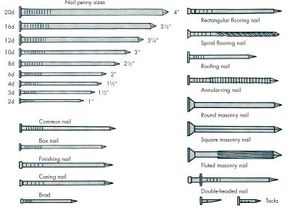What follows are some of the most common nail types:
Common Nails
Used for most medium to heavy construction work, this type of nail has a thick head and can be driven into tough materials. They are characterized by their thick shank and wide, flat head. Ideal for rough framing, they provide strong holding power in wooden structures.
Common nails are made from wire and cut to the proper length and are available in sizes 2d through 60d. These nails are often referred to as "standard nails".
Box Nails
Lighter and smaller in diameter than common nails, box nails are designed for light construction and household use. Their lighter gauge makes them less likely to split thin wood.
They are perfect for jobs that require less holding power. True to its name, box nails are a go-to for small crates and boxes.
Finishing Nails
Finishing nails are lighter than common nails and have a small head. They are often used for installing paneling and trim where you do not want the nail head to show.
Their thinner shank reduces wood splitting, making them perfect for fine woodworking and crafting furniture.
Roofing Nails
Usually made with galvanized steel for weather resistance, roofing nails have a much larger head than common nails. This helps to prevent damage to asphalt shingles.
Specifically designed for roofing, these nails have a broad, flat head and a short shank. Used to secure shingles, they ensure durability against harsh conditions.
Drywall Nails
Nails made for drywall installation are often ringed and have an indented head. Annular-ring nails have sharp ridges all along the nail shaft, providing greater holding power.
Masonry Nails
There are three types of masonry nails designed for use with concrete and concrete block: round, square, and fluted. Used in attaching wood to masonry, they are essential in construction.
Masonry nails should not be used where high strength is required. Fastening to brick, stone, or reinforced concrete should be made with screws or lag bolts instead.
